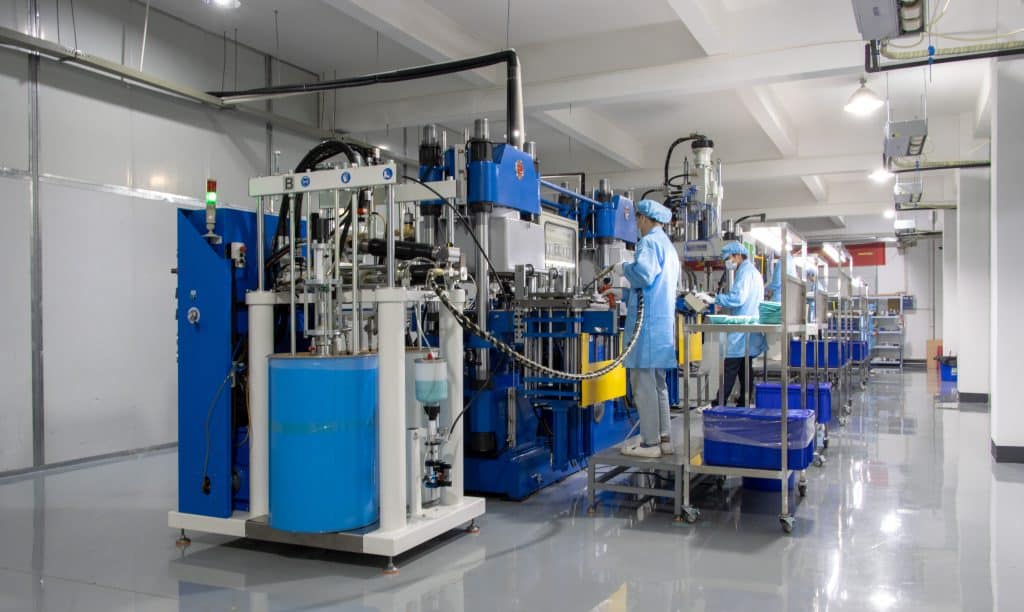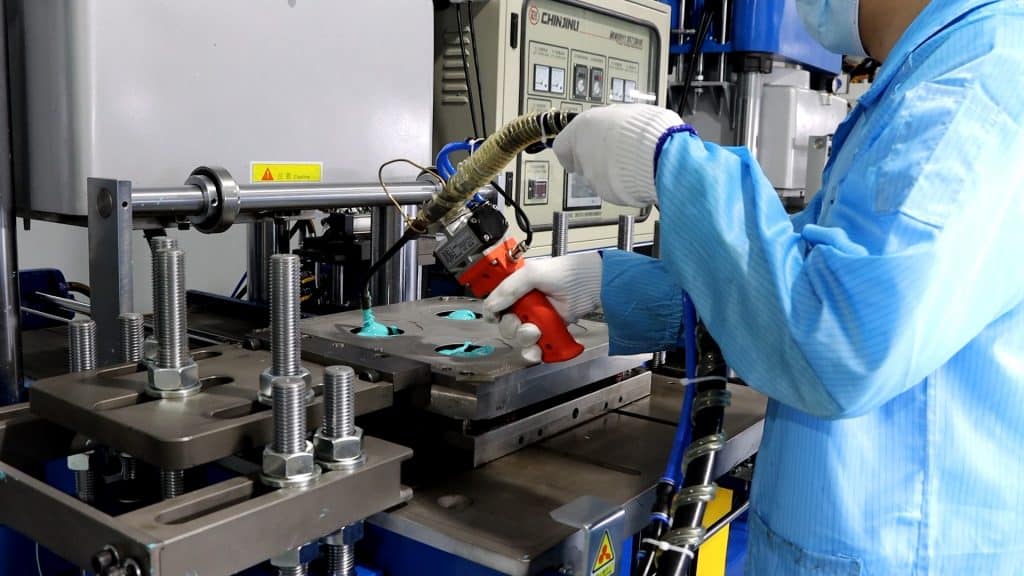
WHAT IS SILICONE TRANSFER MOLDING?
A manufacturing method that lies between injection and compression molding is silicone transfer molding. In some ways, silicone transfer molding is similar to injection molding; this is especially true when it comes to the equipment needed and the intricacy of the process.
The material is pushed into the mold cavity after being placed in a transfer pot in transfer molding. Combining the accuracy of injection molding with the ease of setup of compression molding, it does well in producing medium-volume, high-quality parts with exact specifications as well as tight tolerances, especially when working with silicone materials.
WHAT IS TRANSFER MOLDING PROCESS?
A common manufacturing technique for creating accurate silicone rubber components is silicone transfer molding. It has particular appeal for medium-to-high volume production of parts that require to have intricate details and tight tolerances.
• Preparing the Materials
To ensure consistent chemical properties, two-component silicone rubber (a base and a curing agent) is thoroughly mixed in a predetermined ratio.
• Adding the material
The silicone mixture is transferred into a pot that is placed over the mold cavity. A precise amount of silicone material is prepared for transfer into the mold thanks to this step. Strategic placement of the material in the pot implies controlled movement of the material under pressure into the mold.
• Press Closure Molding
The mold, which encloses the transfer pot, is composed of two or more metal halves. The final part’s precise details, texture, and shape are all defined by this mold. A sealed environment is generated by closing the mold around the transfer pot, which is required for the controlled application of heat and pressure during the silicone transfer and curing phases.
• The Process of Material Transfer
When the mold is closed, pressure and heat are used to push the silicone into the mold cavity through a gate. Heat makes silicone less viscous, which makes it easier to pour into the mold; pressure guarantees full cavity fill and replication of the mold’s fine details.
• Curing Process
The silicone rubber goes through a chemical process called curing after the mold cavity is filled, solidifying it into its final shape. Cross-linking within the silicone polymer is started by the heat applied during the transfer process, which activates the curing agent in the silicone compound. The physical properties and structural integrity of the molded part are the outcome of this transition from a liquid to a solid state.
• Mold Opening and Part Ejection Procedure
The silicone part is extracted from the mold once it has been cured. The mold’s design, which frequently involves elements like ejector pins and draft angles, allows for easier release of the cured part. At this point, the molding cycle is finished, and the silicone part that has solidified correctly reflects the design specifications of the mold.
• Reprocessing
The finished component might need to be trimmed to remove flash and might also need to go through extra finishing phases or quality checks. Post-processing makes sure that the finished product satisfies all requirements for dimensional and visual quality.
SILICONE INJECTION MOLDING VS SILICONE TRANSFER MOLDING
Silicone injection molding and silicone transfer molding are two prominent techniques used in the production of silicone parts, each offering unique benefits and presenting certain limitations.

Silicone Injection Molding——silicone rubber (LSR) is injected under pressure into a mold cavity during the molding process. This process offers outstanding precision and repeatability, making it very effective for producing complex parts in large quantities. The process is ideal for large-scale production because it is automated, which lowers labor costs and guarantees consistent quality. Another advantage is the low amount of post-molding labor needed, like trimming, which raises the overall cost-effectiveness in huge quantities. However, silicone injection molding has a noteworthy setup cost that includes pricey molds and machinery, so it might not be affordable for small production runs.
Silicone Transfer Molding——In contrast, silicone is heated in a chamber before being forced into the mold cavity by a plunger in a process known as silicone transfer molding. This method fills the gap between injection and compression molding; for medium volume production, it is less expensive than injection molding and provides a better surface finish than compression molding. Compression molding renders harder to mold parts with intricate shapes and undercuts; transfer molding makes this possible. Nevertheless, there are certain disadvantages, like increased material waste in comparison to injection molding and the possibility of air entrapment in the silicone, which may degrade the final product’s quality.
SILICONE COMPRESSION MOLDING VS SILICONE TRANSFER MOLDING
Silicone Compression Molding—— A pre-measured piece of raw silicone material is inserted into an open mold cavity, compressed with heat and pressure until it cures, and this process is known as molding. The method is well-known for being easy to use and having inexpensive tools, which makes it perfect for small to medium production volumes. When it comes to larger, simpler parts or products where contour and detail precision is not absolutely necessary, compression molding works especially well. It can hold large inserts and allows for significant variations in part thickness. Comparing the procedure to other molding techniques, it is generally slower and less accurate. difficulties like uneven material qualities, the possibility of air entrapment, and the manual labor needed to place the product can all smaller the final product’s quality.
Compression and injection molding components are combined in silicone transfer molding, however. Using a plunger and a gate and runner system, silicone material is first put into a transfer pot and then compressed into the mold cavity. Enhanced control over material placement and decreased air entrapment are two benefits of this process that lead to better-quality parts with more consistent mechanical properties and smoother surfaces. Parts with complex details and complex geometries are better suited for transfer molding. However since a transfer pot is required and a more challenging mold design is required, the setup for transfer molding can be more complex and pricey than for compression molding.
APPLICATIONS OF SILICONE TRANSFER MOLDING
Because silicone transfer molding can produce precise, high-quality silicone parts with complex geometries, it is a versatile manufacturing process used in a wide range of industries. The superior finish of the products and the excellent material properties make this method especially valuable.
• Automotive and Electronics Industries
Silicone transfer molding is used in the electronics industry to create insulating covers, seals, and other components that need high electrical insulation and thermal stability. Keypads, gaskets, spark plug boots, and other components that benefit from silicone’s heat resistance and durability are molded for use in automobiles. These sectors respect transfer molding’s accuracy and dependability in meeting exacting requirements and high standards of quality.
• Medical Devices
Because silicone transfer molding can produce parts that are chemically inert, biocompatible, and sterile, it is essential in the medical industry. Components for medical equipment like masks, diaphragms, and valves are commonly used. The process’s capacity to yield parts with clean surfaces and free of impurities is crucial in medical applications where product integrity and hygiene are critical.
• Consumer Products
A lot of consumer goods, including bakeware, kitchen utensils, and protective cases for electronic devices, are made using this technique. Silicone is perfect for these applications due to its flexibility, non-toxicity, and heat resistance, and transfer molding provides the ability to generate high-quality, long-lasting products rapidly.
